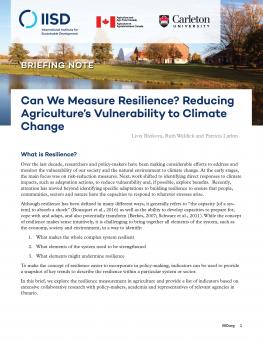
Can We Measure Resilience? Reducing Agriculture’s Vulnerability to Climate Change
Thirty-six indicators make up this framework to promote resilience to climate change impacts and vulnerabilities in Canadian agriculture.
Over the last decade, researchers and policy-makers have been making considerable efforts to address and monitor the vulnerability of our society and the natural environment to climate change.
Recently, attention has moved beyond identifying specific adaptations to building resilience to ensure that people, communities, sectors and nature have the capacities to respond to whatever stresses arise. A framework was developed based on input from over 100 experts representing local, provincial and federal government, as well as non-governmental agencies in agriculture, environment, rural development and health to identify potential impacts of concern. Thirty-six indicators were identified within six themes: climate change, population, farmland production activities, market and economy, rural infrastructure and natural environment. Indicators were advanced from the more traditional measures of the environment or society—like number of hot days or average rainfall and number of people employed in agriculture—to create regionally meaningful changes in the timing, extent or features of impacts or outcomes.
Participating experts
You might also be interested in
National State of the Environment Report: Uzbekistan
The National State of the Environment Report (NSoER) is a comprehensive document that provides a snapshot of current environmental trends in Uzbekistan's socio-economic development for citizens, experts, and policy-makers in the country of Uzbekistan.
Blackouts and Backsliding: Energy subsidies in South Africa 2023
Blackouts and Backsliding presents the latest energy subsidy data for South Africa.
UNFCCC Submissions Tracker
Tracking and sharing opportunities for stakeholders to give input to the UN climate change negotiations.
The State of Global Environmental Governance 2023
In global environmental talks in 2023, the focus across nearly all issue areas was funding implementation and reviewing performance.